Oleg Goes To Sebring
Published: January 16, 2017
As part of my program to run some away tracks this winter, I went to Sebring with NASA Florida.
Getting There
The weather varies quite a bit across the country in January. In New Jersey the ambient temperature was about 30 degrees and it was snowing, forecast called for an inch of snow accumulation. I just bolted some wood pieces to the trailer deck the day before and with snow tires (almost new Blizzak WS80, pretty much the best snow tire on the market today) I had a hard time getting the car on the trailer. In fact I managed to stuff the car into the middle hole between the ramps at one point...
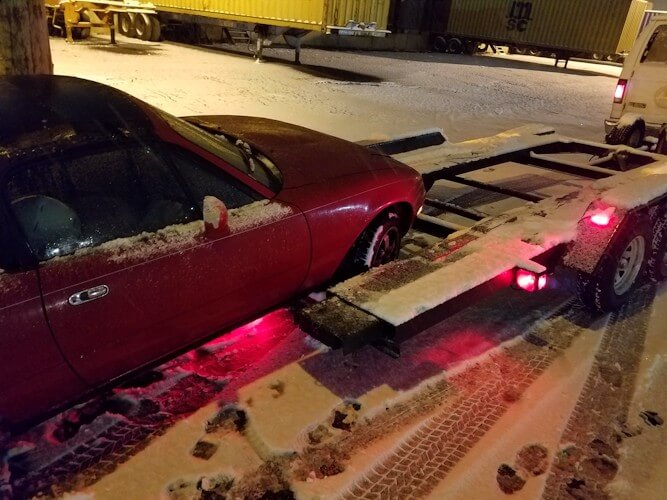
Luckily I own a big jack so this was not a showstopper. Pick up the Miata until it is clear of the trailer, drive the trailer out from under the Miata, put the Miata down, try loading it again.
The drive out of Jersey was all through salted roads, the car looked white by the time I got to Virginia:
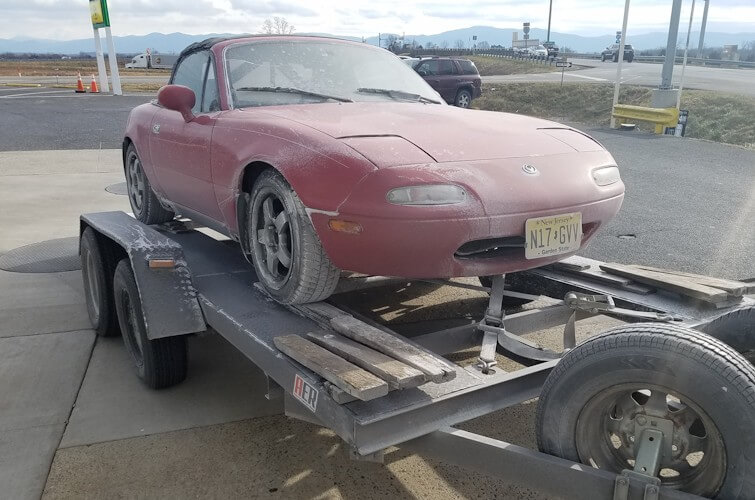
I'm thinking I need to stop at a car wash before getting to the track, but six hours later I am in South Carolina and the ambient temperature here is 44 degrees, and it is raining. Another six hours later and I am in Florida getting downpoured on, and it is almost warm enough to drive with open windows. By the time I get to Sebring it is still downpouring but the ambient temperature is now 69 degrees, and my car looks like it just came out of a car wash.
Ambient temperature on Saturday was in the 70s, the low overnight was about 35 and the high on Sunday was in the low 50s. Quite a swing.
The Track
One of the most enjoyable aspects of track driving for me is getting to a new track and figuring it out as I am driving it. I generally do not look at videos or any sort of track notes ahead of time. Sebring was no exception - I knew that there is a sweeping right that is very open and a left turn that's close to a wall, and that the track was flat. I have not even looked at a track map before going out.
I had been warned that I would get "disoriented" at Sebring. Wikipedia says pro drivers have gotten lost there. I guess I can imagine this happening if their first stint was at night with no other cars around to show them the way, but in an HPDE setting getting lost is pretty hard to pull off. You pretty much just follow a car similar to the one that you are driving that looks like it knows what it's doing (race livery is a good indicator of this, time trial markings not always), and do what that car does. Easy.
I've also driven Watkins Glen (3.4 miles), Pocono Mega (3.5 miles) and VIR Grand (4.2 miles), so a 3.7 mile lap clocking in at 3½ minutes in the wet does not exactly faze me. The trick is segmenting the track into pieces such that the overall number of segments is manageable but you know what to do in each segment once you get to it. In case of Sebring, all tight turns in the middle of the lap are right handers, and they are followed by straights, which means I start all of them with conservative entries and late apexes. Turns 17 and 1 are high speed and the car hugs the wall in both of them. Turns 15 and 16 are medium speed right handers with usable apex and exit curbs. This leaves turns 3 and 5 which are slow lefts and demand patience in the approach, late apexes initially and good vision. Hence despite the track having 17 corners I only needed to know which of the 4 section types I was approaching during the first session.
Here is my very first session at Sebring. Pardon the atrocious wind noise, I was unable to locate the camera part of my Smartycam and had to use a Replay XD:
My student was another data point. He got a late start to the event and only got out once on Saturday in the very last session. He has never driven Sebring but had about 8 track events elsewhere, including those with open passing. He had a healthy dose of aggression but appropriate restraint combined with some solid driving skills. By the end of his first session in HPDE 1 he was running HPDE 3 pace and I don't think was passed once. Did I mention he attained this feat in a Spec Miata?
Finally, I was looking at cars that were passing me in the corners (of which there weren't many even in HPDE 4) and turns out one of such cars was piloted by a fellow Mid-Atlantic instructor, Christina Lam. It was also her first time at Sebring.
Now, this is not to say that the track drives itself, but it seems that truly advanced level drivers don't have too much trouble with the lap.
Turn Notes
These are for a Miata with a stock-ish power level, higher power cars will definitely drive differently!
Turn 1
A blind sweeping left, the key in this turn is consistency and confidence. The turn is somewhat bumpy but this is manageable in a Miata. Turn in point is end of the pit wall on the right. Depending on horsepower and suspension one can brake roughly at the turn in point or just past the turn in point while already turning. Very little braking is required. Get to the inside wall and hug it for most of the turn. The car should track out almost to the exit curb at the end of the corner.
Turn 3
The slow left. My first sessions at Sebring were wet and I was taking this turn quite cautiously, but it actually has quite a bit of grip with good tires (I switched to Maxxis RC-1 on Sunday). Trailbrake to get the car rotated into the turn. A sufficiently late apex is needed but this is not really a very deep entry in a Miata, if trailbraking.
Turn 5
This is like turn 3 all over again. A Miata can brake lightly here to set the nose down or come in with a wider arc and turn in without braking. The no-braking option appears to be quicker, both in the car looking at realtime delta and after the event looking at data.
Turning in sufficiently late is critical - the car should turn in approximately at the beginning of the concrete patch that runs through turn 5. If not braking, swing the car wide prior to the patch and turn in from the right side. If braking, the car can be more in the center and perhaps go a hair deeper into the corner prior to turn in.
The exit curb, while steep, helps get a couple more miles per hour coming out which is important. The curb looks brutal but there is a way of hitting it in a surprisingly flat fashion. I think the trick is getting almost all of the rotation done prior to the curb and using the curb purely as a pavement extension, not to stop the car sliding off the track. Taken this way, the curb is gentle enough to not present a problem and can be consistently aimed for.
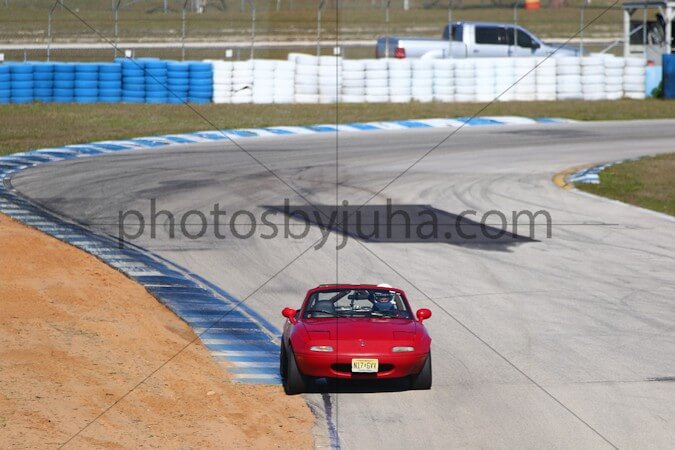
Looking at this photo, the curb is much less steep than what it looks like from inside the car, which is what makes it work. Note that the car has zero steering angle, in fact I am already turning right slightly.
Turn 7
A slow, late apex right going into a chicane with wide rumble strips on either side. Using both right and left rumble strips straightens the corner enormously and makes up gobs of time on drivers that keep their car to the middle. Trailbraking is crucial in this turn to get the car properly rotated at turn in. This is the only corner on the track where I was using second gear, in large part because the car simply did not rotate enough while in third.
Similarly to turn 3, the pavement going into turn 7 felt very slick in rain on street tires and quite grippy in the dry on R compounds.
I've tried a center-ish approach in the wet and it did not seem to be beneficial compared to a traditional left side approach.
Turn 10
This is somewhat of a rehash of turn 7 but with more speed. I was using second gear here on street tires (BFG Rivals) but on R compounds third gear worked much better, as the car would not have any revs left in second gear at the exit.
The exit is more open than it initially seems which permits carrying quite a bit of speed into and through the turn. The car should track out all the way to the curb on the left at the exit, which is almost the apex of turn 8 also. In a Miata the car is accelerating slowly enough that it fits into turn 8 quite easily even starting turn 8 from the left side of the track.
Like in turns 3 and 7, the entry in turn 10 felt slippery in the wet but quite sticky in the dry. I was pushing the car deeper and deeper into the braking zones and the car kept rewarding me with success.
Turn 13
This turn in my opinion requires the most precision of the entire lap. It's a late apex turn that feels slow but is really not - minimum speed in turn 13 is about 5 mph higher than in turn 10 and 15 mph higher than in turn 7. The challenge is that the apex curb is way too steep to use even for cars that can crush most curbs without too much drama, which my car is certainly capable of.
Exit speed is crucial so a sloppy entry is disastrous, but being overly conservative ruins the lap time just as easily. End of the curb on the left is a good turn in point.
This is the only turn with camber to it in the whole lap. The camber eases the turn in and contributes to making the turn faster.
Use the exit curb for the extra foot of track width.
Turn 15
A quick blind exit sweeper, this turn has mountains of potential. Confidence and consistency along with vision are again key. The entry is slippery especially if executing a later entry, double so for an unintentionally late entry. Trying to stuff the car into the turn after missing the fairly early turn in point consistently resulted in the rear end stepping out for quality drifting action. I suspect that because of this Miatas - which typically turn in earlier and at higher speeds than higher power cars - obliterate higher power machinery in this corner.
Using the apex curbing can be a good idea, and when taken properly the car should track out all the way to exit curbing on the left. Going over the exit curbing is probably not a wise idea unless the dampers in the car are really good, I would force the car to stay on the pavement instead. Fastest lines through turn 15 make setup for turn 16 challenging but doable. Miatas have minimal power hence they can be muscled around between 15 and 16.
Turn 16
This turn is quite similar to turn 15 in that a very fast entry is possible. Unlike turn 15 this is an exit speed turn, hence the entry should be a little more conservative than that in turn 15. Fortunately there is no track boundary on the left going into turn 16 meaning an ambitious driver can widen turn 16 to match the desired entry and exit speeds.
Exit curb in turn 16 is about 2/3 of a Miata wide and should be used by advanced drivers.
Turn 17
Easily the signature turn of Sebring, this corner is the most difficult one to figure out as well as to execute. There are enormous bumps on the ideal line which cost time as the tires slide sideways plus provide ample opportunities for unwanted oversteer. The best line I've managed is running a diagonal from turn in point through the right edge of the track, starting to brake on this diagonal, allowing the car to come track left to about middle of what other cars are doing, then turning in toward the apex which is adjacent to the wall, hugging the wall for a few car lengths, then tracking out all the way to the wall on the left prior to the main straight beginning. This is a very similar approach to turn 1 except the car goes wide between turn in and apex because the turn is so long.
Wider lines I've tried were all slower although in the earlier sessions I've had other Miatas pull me on the main straight with a wider swing in the middle of turn 17. I was side by side with them through turn 17 though which brings into question whether they were actually faster than me had we both been on clear track.
A faster line through turn 17 would avoid more of the bumps and maintain tires on the pavement for longer. I'm quite certain the speed I lose is due to the car bouncing and sliding sideways as a result around 3/4 of the way into the turn.
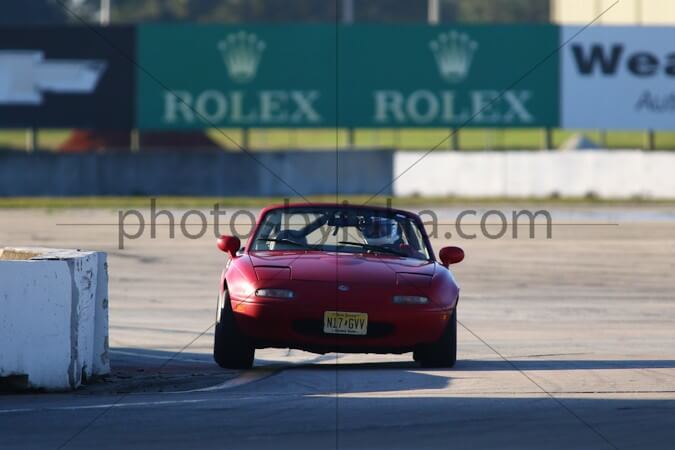
Looking at this photo (which I think is an awesome shot by the way), the car is still a good ways off the apex wall and it looks like it's about to fall into the dip. A deeper entry that puts the car another foot inward at the apex should be flatter topographically and therefore faster.
General Thoughts
The keys to doing well at Sebring, in my opinion, are:
- Track segmentation into a manageable number of pieces;
- An understanding of exit speed corners, and patience in them;
- Big vision and confidence in the high speed corners;
- Good execution of trailbraking and left foot braking;
- Understanding of curb mechanics and appropriate curb usage.
I have not found lack of elevation to be a challenge; in fact, I consider a flat track to be easier to figure out than a three-dimensional track. Sebring has a single turn which has a bit of camber, and is otherwise flat being built on airport runways and similarly graded terrain.
Trailbraking is probably necessary to rotate the car into turns 3 and 7. A non-trailbraking driver will likely struggle in those corners.
Left foot braking is obviously car-dependent but I think it's fair to say that, given the range of cornering speeds, there should be 1-2 corners that would benefit from left foot braking in any car. For a Miata those are turns 1 and 16, and left foot braking in those corners permits very high entry speeds which makes them quite exciting.
Lap Times
My lap times were:
- 3:26, first session, wet, 205/50-15 BFG Rivals;
- 3:04 and 3:08 on a drying then damping track, Rivals;
- 2:52 in the last session on Saturday on a virtually dry track, 245/40-15 Maxxis RC-1;
- 2:50, 2:48, 2:47 and finally 2:46 on Sunday in the dry on RC-1s.
Final session with the 2:46 lap:
Spec Miata lap times were 2:40-2:43. What was very interesting was Spec E30 lap times were in the 2:36 range at the pointy end of the field, suggesting that horsepower accounts for a lot of the lap time. My 97 Miata runs roughly SSM pace which is a couple seconds per lap slower than SM pace.
I would say there is another maybe half a second available in turn 1 with more a consistent entry and later and harder braking as a result, perhaps a quarter second in turns 3, 7, 10 and 13 with a more aggressive entry and harder braking again, at least a half second in the big bend with an awesome exit out of turn 5, and probably a full second in turn 17 if there is a way of driving around that turn without going airborne but while maintaining the speed. With better shocks and a limited slip diff I can see at least another half a second coming out of turn 7 and another coming out of turn 16, and perhaps a quarter second between in turn 15 exit. To sum those times up I should aim for a 2:43 with the car as it sits and 2:42-2:41 in an SSM. Not far off actual SM times this weekend.
Validation
I've watched some Spec Miata videos at Sebring after getting home from the event, and I was pleased to observe that I settled into Spec Miata lines as well as gear selection (2nd in turn 7 only, 3rd gear and up elsewhere). One video did have the camera car carry 3rd through turn 7 but I think it's slow on the balance of things, as long as the driver is able to consistently not botch the 2nd-3rd upshift.
Somewhat of a revelation was the driver in this video obtaining 112 mph on the back straight, when my top speed there was 103 mph on data and somehow 105 mph in the video. How the speed in Race Studio is different from speed in the video which uses data exported from Race Studio is a separate inquiry. Even assuming 105 mph was my actual speed, 7 mph delta is substantial. 9 mph delta is huge. My student with me riding shotgun got to 104 mph in a 1.6 SM as shown in Race Studio, with lower cornering speeds. A 10 mph top speed deficit would definitely explain a few seconds of lap time between me and Spec Miatas.
On a more satisfying note I was within 1 mph of SM minimum corner speed (69 vs 70 mph) in turn 17, at least going by the one video I've looked at that showed a speedometer. Granted I was running a much wider tire, but supposedly Hoosiers are a lot stickier plus suspensions are different so who knows which car has more mechanical grip.
Damage Tally
No away event would be complete without something breaking on the car! When I went out for a lead/follow HPDE 3 session with my student I heard and felt what seemed like a wheel bearing going out. However there was no significant play in any of the wheels. After I pulled the rotors off on the offending (loaded) side, my student spotted the problem:
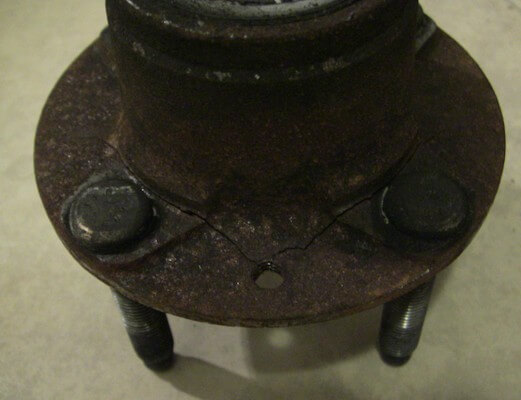
This is the second Timken hub I've had crack on me. The first one I did not catch in time due to square Hoosiers hopelessly vibrating the rest of the car, the result was the left front wheel flying off the car in VIR turn 1. This hub I did catch. The first failed hub also did not exhibit visible wheel bearing play in the remains of the center section. Both hubs were repacked with Swepco grease and had ARP studs installed. I do not use spacers on track but I used them in street driving prior to putting snow tires on. The first hub had about 2 hours of track time when it catastrophically failed and the second hub had about 6 track days plus a thousand miles of street driving.
Besides another dead hub, the header to exhaust nuts started to back out and the gasket there was ruined, resulting in a medium exhaust leak. Winning HPDE championships does not come free.
 Visit our
Visit our